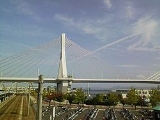
Aomori Bay Bridge
Encyclopedia
The is a cable-stayed bridge
in Aomori
. It was constructed in order to alleviate cargo ship traffic. It is a famous part of Aomori City's scenery.
after the 1323.7 meter Hachinoe Oohashi Bridge. Previously the longest bridge in Aomori City was the 993.9 meter Aomori-nishi Bypass overpass which is currently the third longest bridge in Aomori Prefecture.
Emphasis was placed on the aesthetics of the bridge causing the total cost of construction to come to approximately 27 billion yen in comparison to only 8.9 billion yen for the longer Hachinoe Oohashi Bridge. An example of the emphasis on the bridge's appearance is the emblazoning of the letter "A", for "Aomori", at various places such as the base of the bridge and in the shape of the suspension cables. The use of the letter "A" continues on from the nearby Aomori Prefecture Tourism Center “Asupamu”, which is built in the shape of a triangle so that it would look like the initial "A".
The bridge's main tower is made from high strength concrete.
In response to the bridge's long standing problems with ice in the winter months, a plan was made to lay pipes circulating sea water under the road surface to melt the ice. However, due to problems related to the cost and construction time, only one section was able to be completed. As yet there are no indications of when the system will be implemented over the remainder of the bridge as originally planned. Even so, since the installation of the system the number of traffic accidents has drastically decreased.
Cable-stayed bridge
A cable-stayed bridge is a bridge that consists of one or more columns , with cables supporting the bridge deck....
in Aomori
Aomori, Aomori
is the capital city of Aomori Prefecture, in the northern Tōhoku region of Japan. As of 2009, the city had an estimated population of 302,068 and a density of 366 persons per km². Its total area was 824.52 km².- History :...
. It was constructed in order to alleviate cargo ship traffic. It is a famous part of Aomori City's scenery.
Details
The Aomori Bay Bridge is the longest in Aomori City at 1219 meters. It's the second longest bridge in Aomori PrefectureAomori Prefecture
is a prefecture of Japan located in the Tōhoku Region. The capital is the city of Aomori.- History :Until the Meiji Restoration, the area of Aomori prefecture was known as Mutsu Province....
after the 1323.7 meter Hachinoe Oohashi Bridge. Previously the longest bridge in Aomori City was the 993.9 meter Aomori-nishi Bypass overpass which is currently the third longest bridge in Aomori Prefecture.
Emphasis was placed on the aesthetics of the bridge causing the total cost of construction to come to approximately 27 billion yen in comparison to only 8.9 billion yen for the longer Hachinoe Oohashi Bridge. An example of the emphasis on the bridge's appearance is the emblazoning of the letter "A", for "Aomori", at various places such as the base of the bridge and in the shape of the suspension cables. The use of the letter "A" continues on from the nearby Aomori Prefecture Tourism Center “Asupamu”, which is built in the shape of a triangle so that it would look like the initial "A".
The bridge's main tower is made from high strength concrete.
In response to the bridge's long standing problems with ice in the winter months, a plan was made to lay pipes circulating sea water under the road surface to melt the ice. However, due to problems related to the cost and construction time, only one section was able to be completed. As yet there are no indications of when the system will be implemented over the remainder of the bridge as originally planned. Even so, since the installation of the system the number of traffic accidents has drastically decreased.
Development
- 1982 – Project created (Project name: Aomori Port Improvement Project, planned to bridge a 1993 meter section)
- 1985 – Construction begins
- 1992 – July – Tentatively, two lanes are opened for traffic. The project receives the Doboku Gakkai Tanaka award for outstanding bridge construction projects.
- 1994 – July – All four lanes are opened for traffic.
- 2002 – Projects to increase earthquake resistance and to prevent icing begin. (Project name: Aomori Port Area Bridges (Earthquake Proofing), total budget of approximately 2.5 million yen.)
- 2004 – December - De-icing systems begin being used on 442 meters of the downhill part of the Okidate side (West side) of the bridge.
- 2006 – February – De-icing systems begin being used on 138 meters near the intersection of the Hon-machi side (East side). 253 meters of de-icing systems are planned to begin being used from the Hon-machi side to the Okidate side during the winter of 2006.
Major Connecting Roads
- Aomori Prefectural Route 18, Aomori Port Route (commonly referred to as Yanagi-machi Avenue)
- Port Road Route 1 (Western Road)
- Port Road Route 3 (Eastern Road)
Surrounding Area
- Aomori StationAomori Stationis a railway station located in Aomori, Aomori, Japan. The station opened on 1 September 1891.-Lines:Aomori Station is served by the following lines.*Ōu Main Line *Tsugaru-Kaikyō Line *Aoimori Railway Line...
- Seikan Connector Ferry Boat Memorial Ship “Hakkouda-maru”
- Aomori Prefectural Tourism Center “Asupamu”
See also
- Yokohama Bay BridgeYokohama Bay BridgeThe is a 860-metre-long cable stayed bridge in Yokohama, Japan. Opened September 27, 1989, it crosses Tokyo Bay with a span of 460 metres . The toll is ¥600. The bridge is part of the Bayshore Route of the Shuto Expressway....
– The inspiration for the name of the Aomori Bay Bridge.

